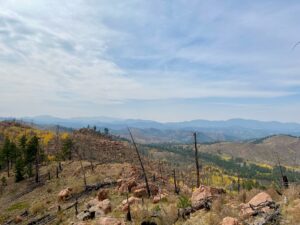
By September of this past year, both California and Colorado had experienced record-breaking wildfires, exceeding previous history for the largest wildfires in their respective states. According to the National Interagency Fire Center, more than 7.5 million acres had burned across the United States by Fall 2020, surpassing the approximate 6.1 million acre 10-year annual average (NIFC, 2020). Why have we seen increasingly disastrous wildfires in recent years?
Enter stage right the mountain pine beetle. Approximately 5 mm in length with an average life span of one year, the mountain pine beetle may not seem like a formidable opponent, but like all ecosystems, each member is densely interconnected (USDA FS, 2011). An imbalance of one species always equates to consequences for another.
One of 17 species of bark beetles native to North America, the mountain pine is a wood-boring insect that has shaped the forest landscapes from Canada to Mexico for thousands of years (NPS, 2018). From July to August, adult pine beetles colonize forests in search of larger trees (typically no less than 3 inches in diameter). Affected pine species include Lodgepole, Ponderosa, Western White, Whitebark, Jack, and Limber pine. Once a suitable host has been identified, female beetles excrete a pheromone signaling other beetles to follow (Katz, 2017). Females then begin eating tunnels called galleries into the inner bark of the tree, extending up to 30 inches or more from the attack site. The eggs hatch and beetle larvae continue burrowing and feeding until winter freezing temperatures trigger dormancy. By June or early July, larvae pupate and emerge from the tree in search of new hosts to repeat the cycle. Within one year of invasion, infested trees can fade from green to red-brown and die (USDA FS, 2011).
Healthy trees can defend against pine beetle invasions by producing a thick toxic resin that repels and kills intruders. Furthermore, harsh winters can cause significant mortality across beetle populations (Katz, 2017). So, with effective defense mechanisms for the trees in place, why are pine beetles the villain of this story?
Recent and persistent droughts prevent sufficient water and nutrients from fueling trees, reducing their ability to produce resin and ward off beetles. As a result of increased human CO2 production, global warming triggers milder winters and warmer drier summers, contributing to beetle population growth and survival. Pine beetles are now not only expanding to new territories as a result of temperature changes but hatching earlier and reproducing more often. Moreover, with a decreasing population to host on, scientists are observing beetles attacking younger trees formerly deemed undesirable. Since 2000, pine beetles have ravaged 85,000 square miles of forest in the Western US, and roughly 65,000 square miles of forest in British Columbia. Decades of fire suppression in the US has resulted in an unnaturally dense forest understory, significantly increasing fire risk. Within the first few years of beetle invasion, dead pines still maintain their needles, enabling fires to accelerate quickly from tree to tree in a phenomenon called torching (Katz, 2017).
Unfortunately, increased intensity of wildfires is not the only consequence of pine beetle destruction. Of additional great concern to researchers is the expansion of pine beetles into previously untouched regions, including the northern Canadian boreal forest. “The loss of large swaths of conifers could also turn forests from carbon sinks into carbon sources as infested stands of pine, spruce, and fir stop absorbing CO2, die, and rot, releasing stored carbon” (Katz, 2017). The reduction of carbon-storing forests accelerates the cycle of global warming, increasing temperatures and further spurring populations of pine beetles. Forests in California’s Sierra Nevada region are already experiencing rapid changes, as beetles wipe out nearly all the low-elevation Ponderosa pines. Coupled with drought and a changing climate, scientists fear these trees may not have the resiliency to come back. Unfortunately, the beetle epidemic is not constrained to North America. Forests from Switzerland, Poland, and Germany all the way to Siberia are experiencing exacerbated beetle outbreaks in the Spruce population. According to Jesse Morris, a geographer with the University of Utah, “the amount of conifer mortality that we’re seeing both here and in Europe is unprecedented historically,” (Katz, 2017).
Until we can achieve preventative control of beetle populations, proper forest and land management, and reduction of greenhouse gas emissions on a global scale, we will continue to experience the harsh and accelerated effects of global warming and climate change. More intense wildfires, the disruption of watersheds and wildlife habitats, and reduced carbon absorption and storage by declining forests are only the beginning.
As managers of sustainable and responsible investment portfolios, our commitment lies not only in providing ethically sourced returns for our clients, but in supporting positive impact-driven companies and communities. Conscious investing is achieved through selective avoidance of institutions that harm ecosystems or using the allocation of capital as a lever to change those institutions in conjunction with focusing on institutions that provide regenerative and resourceful solutions to humanities’ needs.
Bibliography:
Katz & Yale School of the Environment. (2017, September 21). Small Pests, Big Problems: The Global Spread of Bark Beetles. Yale E360. https://e360.yale.edu/features/small-pests-big-problems-the-global-spread-of-bark-beetles
National Interagency Fire Center. (2020, October 8). National Preparedness Level 4. https://www.nifc.gov/fireInfo/nfn.htm
National Park Service. (2018, May 29). Forest Health: Mountain Pine Beetle – Rocky Mountain National Park (U.S. National Park Service). National Park Service: Rocky Mountain. https://www.nps.gov/romo/learn/nature/mtn_pine_beetle_background.htm
USDA Forest Service. (2011). Mountain Pine Beetle: Aggressive Bark Beetle of Western Pines. Forest Health Protection, 1–2. https://www.fs.usda.gov/Internet/FSE_DOCUMENTS/stelprdb5299324.pdf
